

Our Vision Leveraging technology, personalizing learning, empowering teachers, accelerating results, elevating our community Our Objective To transform our schools, over the course of the next five years, into blended learning environments.

The Definition of Blended Learning. Educational Leadership:Technology-Rich Learning:The Basics of Blended Instruction. The Online Learning Teaching Techniques. The world of online education is exciting for its potential to reach students individually, but what teaching techniques can do this?
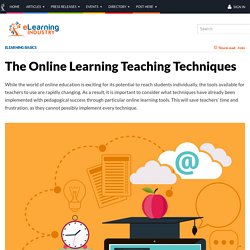
Online Learning Strengths Online learning strengths lie in student empowerment, flexibility, accommodation, customization, collaboration, and creation. Students are empowered through online learning in a number of ways. They are free to access materials whenever and wherever they want, using a system they are comfortable with. This flexibility allows students to learn in a way in which they are successful. Often times, students can customize portions of the course management system (CMS) used by their school for their own personal preference, such as including a picture of themselves; changing the background color, font or font size for reading clarity; and even setting notifications.
Why the traditional learning theories do not work A student-center approach to learning is often referred to as the teacher being ‘the guide on the side’. Favorite Blended Learning Tools - Go - Teacher Tech. Blended Learning- An Introduction to Blended Learning. Blended learning and the future of education: Monique Markoff at TEDxIthacaCollege. Benefits of Blended Learning. Blended Learning: 4 Blended Learning Models. Blended Learning Models. Blended Learning Definitions. The definition of blended learning is a formal education program in which a student learns: at least in part through online learning, with some element of student control over time, place, path, and/or pace;at least in part in a supervised brick-and-mortar location away from home;and the modalities along each student’s learning path within a course or subject are connected to provide an integrated learning experience.
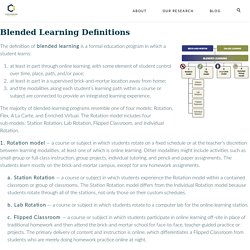
The majority of blended-learning programs resemble one of four models: Rotation, Flex, A La Carte, and Enriched Virtual. The Rotation model includes four sub-models: Station Rotation, Lab Rotation, Flipped Classroom, and Individual Rotation. 1. Rotation model — a course or subject in which students rotate on a fixed schedule or at the teacher’s discretion between learning modalities, at least one of which is online learning. A. B. C. D. 2. 3. 4. Source: Michael B. The Ultimate Guide to Blended Learning Models. Have you heard of Blended Learning?

Youre probably rolling your eyes at the screen. If you've been anywhere in the remote vicinity of the education realm in the past couple years, you've heard of and have probably seen efforts to blend online and offline learning in your classrooms and schools. On a very basic level, Blended Learning is simply the use of online learning (via the web, digital program, or other digital means) and offline learning (traditional brick-and-mortar setting, group-based projects, discussion, etc.) as a means to personalize instruction within the classroom. Videos. Proof Points: Blended Learning Success in School Districts.
September 19, 2015 September 2015 We teamed up with the Evergreen Education Group to publish 12 case studies of how traditional school districts improved student learning outcomes after implementing blended learning.
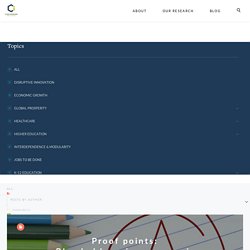
Each short profile highlights key details in the district’s blended-learning strategy, the EdTech products used, and promising results in the form of test scores and graduation rates. Profiles include: District of Columbia Public Schools, Washington, D.C., has redesigned 17 schools to incorporate blended learning. Rethinking Space & Time (Flipped Learning Toolkit #1) The Teacher's Guide To Flipped Classrooms. Since Jonathan Bergman and Aaron Sams first experimented with the idea in their Colorado classrooms in 2004, flipped learning has exploded onto the larger educational scene.
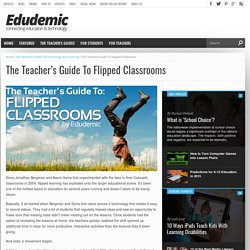
It’s been one of the hottest topics in education for several years running and doesn’t seem to be losing steam. Basically, it all started when Bergman and Sams first came across a technology that makes it easy to record videos. They had a lot of students that regularly missed class and saw an opportunity to make sure that missing class didn’t mean missing out on the lessons. Once students had the option of reviewing the lessons at home, the teachers quickly realized the shift opened up additional time in class for more productive, interactive activities than the lectures they’d been giving.
And voila: a movement began. Research – Flipped Learning Simplified. Shane-mason. As requested, here are the slides I used during my Flipped Classroom presentation at the 2015 Council of International Schools Regional Conference.
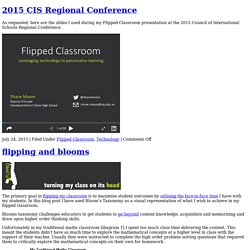
July 24, 2015 | Filed Under Flipped Classroom, Technology | Comments Off The primary goal in flipping my classroom is to maximise student outcomes by utilising the face-to-face time I have with my students. In this blog post I have used Bloom’s Taxonomy as a visual representation of what I wish to achieve in my flipped classroom. Blooms taxonomy challenges educators to get students to go beyond content knowledge, acquisition and memorising and draw upon higher order thinking skills. Unfortunately in my traditional maths classroom [diagram 1] I spent too much class time delivering the content. Â [diagram 1] FlippedLessonPlanning. Jon Bergmann - Flipped Learning. Three Tips for Effective Videos in a Flipped Classroom – Flipped Learning Simplified. ShowMe - The Online Learning Community.
Screencast-O-Matic. 4 Videos to Help you Create Videos for Flipping the Classroom. About ETR Community EdTechReview (ETR) is a community of and for everyone involved in education technology to connect and collaborate both online and offline to discover, learn, utilize and share about the best ways technology can improve learning, teaching, and leading in the 21st century.

12 Ways to Create Flipped Learning Content - No. 4: The FIZZ Method - Flipped Learning Network Hub. The FIZZ Method is a Straightforward, Low Tech Method for Creating Quality Flipped Content Welcome our 4th installment in this series examining different approaches to creating flipped or blended lessons.

So far we’ve taken a look at screencasting, narrating over Powerpoint slides, and using ed.ted.com. Today we explore the “FIZZ Method”. Dr. Lodge McCammon developed this “low-barrier” approach to creating flipped content. In the video below, we see the FIZZ method in action while Dr. It’s “Low Barrier”: it’s simple and very low-techIt requires a deeper level of thinking/planning (and this is a good thing!)
Mysimpleshow - create your own explainer video in minutes. Blend And Flip Learning With Blendspace - Lessons. Beat the end-of-year slump with these 15 ideas to motivate your students.
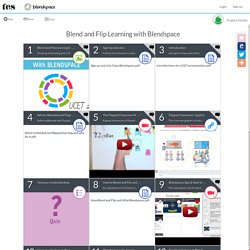
Thinking of blending and or flipping learning in your classroom? Come learn about how Blendspace can assist you in this process. Flip your Classroom with Nearpod. Jon Bergmann on the Flipped Classroom Part 1. Using class time differently k 12. Making the Most of Your Flipped Classroom's In-Class Time. For first-time flippers, it can be easy to get wrapped up in the initial challenges of planning and producing pre-class lecture materials, and lose sight of what that up-front effort earns you.
When you walk into your flipped classroom, you’ll have a room full of informed students, ready to dig in and explore the day’s lesson together with you. This is arguably the element of the flipped classroom most essential to long-term success. Done well, the interactive class time you’ve cultivated by flipping will justify itself in improved student participation, interaction, and performance. Yet, achieving that student-centered learning experience isn’t a given. 3 Ways to Take Your Students Deeper With Flipped Learning.
Editor's Note: This post was co-authored by Aaron Sams, Managing Director of FlippedClass.com and founding member of the Flipped Learning Network. Flipped learning is more than just an efficient way to teach. It is also an opportunity to take students to deeper levels of comprehension and engagement. One of the most important benefits of flipped learning is that it takes the teacher away from the front of the room. No longer is class focused on information dissemination, but instead, time can be spent helping students with difficult concepts and extending the learning to deeper levels. Perhaps the greatest benefit of flipped learning is that it gives teachers more time to interact with students one-to-one and in small groups. Help With the "Hard Stuff"
Flipped-Learning Toolkit: Overcoming Common Hurdles. Editor's Note: This post was co-authored by Aaron Sams, Managing Director of FlippedClass.com and founding member of the Flipped Learning Network. Flipping your classroom is a great way to move from "sage on the stage" to "guide on the side. " But that shift can also bring about a number of other complications. For instance: What if students can't access the internet at home? What if students simply don't know how to watch an educational video? The answers to these questions are in the video above. Pros and cons of teaching a flipped classroom. The concept of “flipped classrooms” has been a hot topic for the past couple of years.
Can instruction be effectively delivered at home, freeing up class time for debates, projects and labs? The model flips the traditional approach of using class time for explaining concepts and homework for reinforcement. In the beginning, many teachers dove all in, but soon faced challenges. Then it started to lose favor. Anecdotally – we’re hearing it’s making a comeback. When flipping their class, those most typical use case we see is where teachers provide lesson materials the night before class as online video, podcasts, blog posts or interactive courses, and then plan a collaborative project for class time. Modifying the Flipped Classroom: The "In-Class" Version. So. You've tried flipping your class, and it didn't go well. Or you've heard about flipping and want to try the approach, but you're pretty sure it won't work in your school.
Don't give up yet -- with a slight twist, flipping might be possible for you after all. Flipped classrooms -- where direct instruction happens via video at home, and "homework" takes place in class -- are all the rage right now, and for good reason. How to Flip Your Class for Students with Little Access To Technology - Flipped Learning Network Hub.